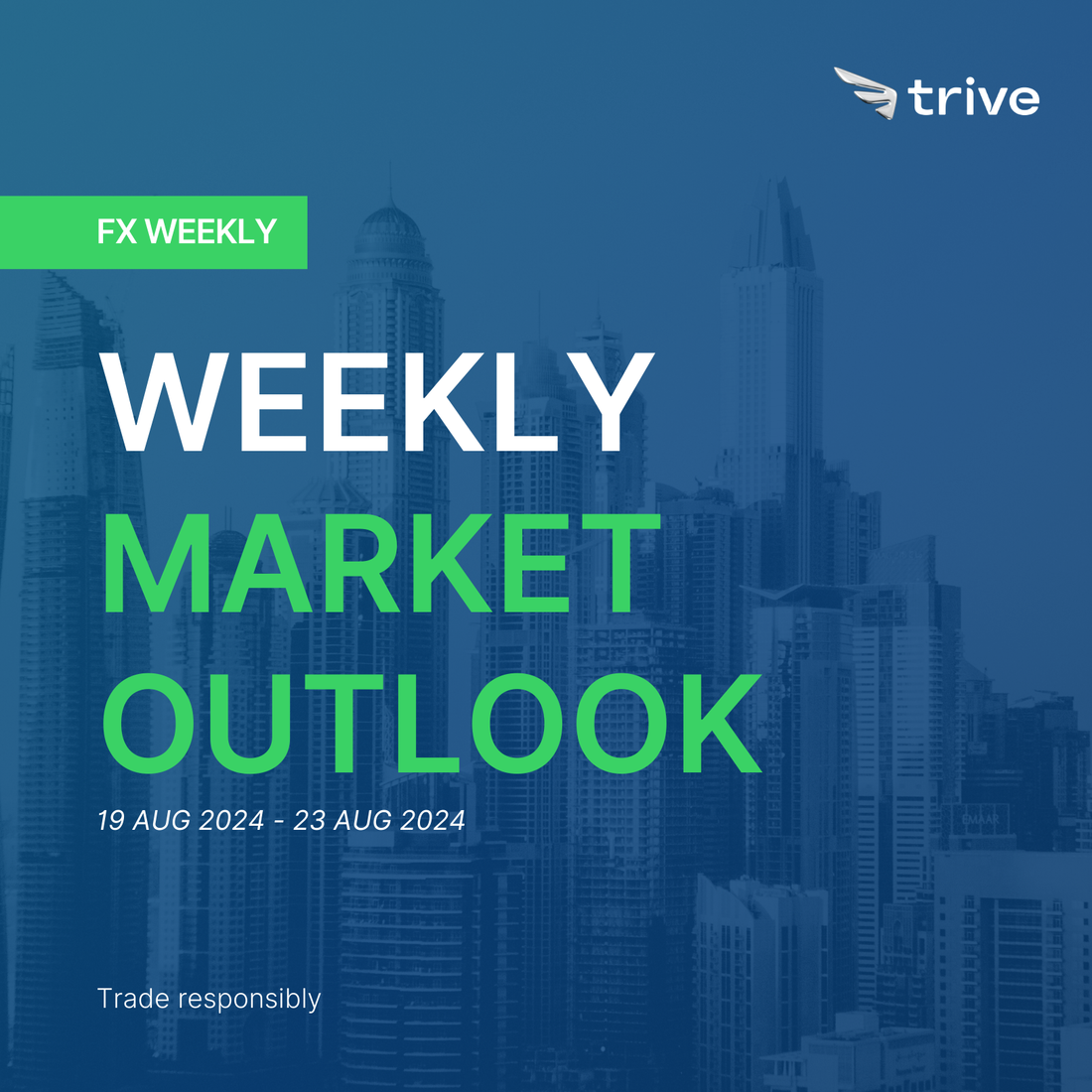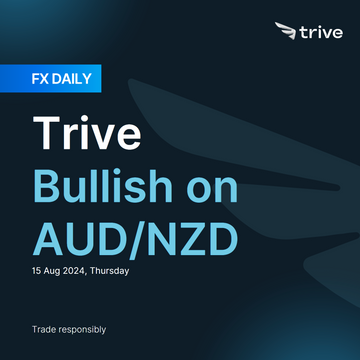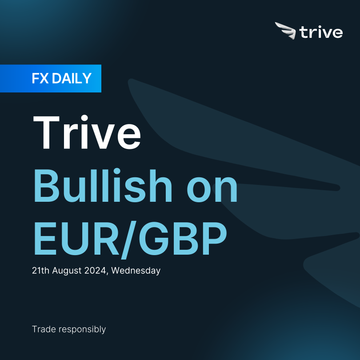FX Weekly: Trive’s Week Ahead Insights

This week's highlights include the Jackson Hole Economic Symposium, and Minutes from the Fed, ECB and RBA, while inflation reports from Canada and Japan will be eyed, as will the global Flash PMI data.
PBOC LPR- Tuesday
PBoC will announce China’s benchmark Loan Prime Rates next week which are likely to be maintained with the 1-year and 5-year LPRs currently at 3.35% and 3.85%, respectively. The likelihood for no adjustments in the LPRs which are the reference for most new loans and mortgages follows the about of reductions conducted in July in which the central bank had initially opted to maintain the 1-year MLF rate at 2.50% at its regular mid-monthly operation in July but then surprised markets with unexpected cuts to its short-term funding rates a week later including the 7-day reverse repo rate which was lowered by 10bps to 1.70% from the 1.80%, while Chinese banks then followed through with similar magnitude cuts to the benchmark 1-year and 5-year Loan Prime Rates. The PBoC also lowered its Standing Lending Facility rates by 10bps across all maturities and unexpectedly conducted a second MLF operation for the month on July 25th in which it cut the 1-year MLF rate by 20bps to 2.30%. Therefore, given the recent cuts to funding rates, it is unlikely that the central will be in a rush to adjust rates so soon, while mixed data releases from China also support a patient approach. As a reminder, it was announced last month that China will change the timing of the release of the monthly LPR fixing to 09:00 local time (02:00 BST/21:00EDT) 15 minutes earlier than the previous scheduled time.
RBA Minutes- Tuesday
RBA will release the minutes from its August 5th-6th meeting which participants will be eyeing for any clues on policy and further insight into the central bank’s thinking. As a reminder, the central bank provided no major surprises at the meeting as it kept the Cash Rate unchanged at 4.35% as forecast by 32 out of 33 economists surveyed by Reuters, while it also stuck to its hawkish tone in which it reiterated that the Board remains resolute in its determination to return inflation to the target and is not ruling anything in or out, as well as reiterated that inflation remains above target and is proving persistent. Furthermore, the central bank said policy will need to be sufficiently restrictive until the board is confident that inflation is moving sustainably towards the target range, while it raised its view for GDP, CPI and the Unemployment Rate with its forecasts assuming the cash rate will be 4.3% in December 2024, 3.6% in December 2025, and 3.3% in December 2026. RBA Governor Bullock stuck to a hawkish tone at the post-meeting press conference in which she noted that the board considered a rate increase and that a cut is not on the near-term agenda, while she also stated that they are ready to raise rates if needed and that the pricing of cuts for the next six months does not align with the board.
FOMC Minutes-Wednesday
Minutes from the July 31st FOMC meeting, due to be released on Wednesday, could be overshadowed by the Jackson Hole Economic Symposium, due to begin on Thursday (see below for our preview). At the July meeting, the FOMC left rates unchanged at between 5.25-5.50%, but it made tweaks to its statement that appear to leave the door open to a rate cut in September. The Committee is now attentive to risks on both sides of its mandate, a change from the June statement, where it said it was 'highly attentive' to inflation risks. The statement said there has been 'some further progress' towards its inflation goal, whereas in June it said there had been 'modest' progress. And it now says that risks to achieving its employment and inflation goals continue to move into better balance, whereas in June it said it was moving 'towards' better balance. The Fed did however reiterate that it does not expect that it will be appropriate to lower rates until it has gained greater confidence that inflation is moving sustainably towards target, suggesting that the Committee still wants to see favourable data before pivoting to rate cuts.
At his post-meeting press conference, Chair Powell revealed that there was a real discussion about the case for reducing rates at this meeting; a strong majority supported not moving (he later said that "overwhelmingly" policymakers felt it was not the time yet). The Fed Chair noted that the policy rate is clearly restrictive, and it is coming to the point where it will be appropriate to start rate cuts and dial back restrictions in order to support the continued progress of the economy. He added that the Fed does not need to be 100% focussed on inflation given upside risks to prices have decreased while downside risks to employment mandate are real now, noting that the chances of a hard landing are low as the economy was neither overheating or sharply weakening. Powell said the Fed is balancing the risk of going too soon against going too late, and has a very difficult judgement call on rates. When asked about the prospects of a 50bps rate cut (two 25bps moves rolled into one), Powell said it was not something the Fed was thinking about right now.
A theme throughout Powell's Q&A was that he tied any future move on the incoming data. Powell said that the Q2 inflation had added to the Fed's confidence on inflation; on the labour market, Powell said does not think the labour market is currently a source of inflation pressures, and that is why Fed does not want to see excess cooling in the labour market. Powell was coy on giving any specific nod to rate cuts, noting that it could reduce rates zero times this year, or even several - it all depended on incoming data. The Fed's focus is now shifting more towards its dual mandate, rather than just the inflation side of the equation; while policy was positioned to deal with dual mandate risks, the Fed is attentive to risks on both sides of the mandate.
CANADIAN CPI- Wednesday
Minutes from the BoC's recent meeting stated that officials would be weighing the forces that could pull inflation below its target vs those that could hold it above target. Some felt that wage growth at current levels could lead to persistent price pressures for many services, and price pressures in services more closely impacted by wages were unlikely to be offset to the same extent as in past months by disinflation in goods or price cuts. Others placed less emphasis on risks that wage growth could contribute to price pressures.
The GC generally saw less chance that any pent-up demand could result in a sudden rise in house prices as rates were being cut. At that policy meeting, the BoC left its end-2024 CPI view unchanged at 2.6% Y/Y (vs 2.7% Y/Y in the June data) but raised its 2025 CPI view to 2.4% Y/Y (vs its previous forecast for 2.2%). BoC Governor Macklem said the central bank did not want to weaken the economy too much and have inflation go below its 2% target; "we need to increasingly guard against the risk that inflation falls too far. We want inflation to come down, but we want it to come down sustainably," he said. The Governor also stated that "if inflation continues to ease broadly in line with our forecast, it is reasonable to expect further cuts in the policy interest rate; the timing will depend on how we see these opposing forces playing out."
ECB Minutes- Thursday
As expected, the ECB opted to stand pat on rates following the 25bps reduction in June. In the accompanying policy statement, the Governing Council reaffirmed that it will keep policy rates sufficiently restrictive for as long as necessary to achieve its goals. Furthermore, policymakers will continue to maintain a data-dependent approach and not pre-commit to a specific policy path. At the follow-up press conference, President Lagarde noted that the discussion on the Governing Council was very much a case of “on the one hand” and “on the other hand”, with the ultimate policy decision being a unanimous one.
Lagarde was also keen to stress that the ECB is data-dependent but not specific data point-dependent. Regarding the path ahead, Lagarde kept her cards close to her chest, suggesting that the September meeting is “wide open”. Given how neutral the meeting was and the amount of data due between July and September, it is unlikely that the account will offer much in the way of guidance over what to expect next month. Instead, traders will be minded to watch EZ data points and how these metrics are viewed by members on the Governing Council.
Eurozone Flash PMI- Thursday
Expectations are for the Eurozone flash August manufacturing PMI to tick higher to 46.0 from 45.8, and services to increase from 51.9 to 52.1, leaving the composite at 50.5 vs. prev. 50.2. As a reminder, the prior release saw the manufacturing print hold steady at 45.8, and services decline to 51.9 from 52.8, leaving the composite at 50.2 vs. prev. 50.9. The accompanying report noted, “the eurozone’s economy is growing at a snail's pace in July. Sector-wise, services are not picking up speed like it did earlier in the year, while the industrial slump has continued unabated”. This time around, Investec suggests that there may be a slight recovery in momentum, however, the global trend in manufacturing still looks “unconvincing”.
On a national level, the focus remains on the poor run of German data with ZEW metrics for August setting markets up for another potentially soft print, whilst the focus for France will be on the impact from the July Olympics after a few months of political turmoil. From a policy perspective, the release may cause some short-term movement in ECB pricing (September cut priced at 90% with a total of 72bps of easing seen by year-end). However, expectations for next month’s meeting are more likely to be impacted by inflation and the wage outlook, on which the latest batch of EZ negotiated wage data will be available on the same day. As a reminder, the Q1 release printed at 4.69% vs. prev. 4.45%. However, the ECB put out a blog alongside the release stating that “negotiated wage growth reflects multi-year adjustments and wage pressures look set to decelerate in 2024”.
UK Flash PMI- Thursday
Expectations are for the flash services print to hold steady at 52.5, and manufacturing to pull back to 52.0 from 52.1, leaving the composite unchanged at 52.8. As a reminder, the prior release saw the services metric rise to 52.5 from 52.1, and manufacturing increase to 52.1 from 50.9, leaving the composite at 52.8 vs. prev. 52.3. The accompanying report noted, “July's accelerated expansion in sales activity crucially suggests business and consumer confidence has improved, and albeit only one month into the second half of 2024, the latest survey results bode well for a reasonable GDP growth print in Q3.”
This time around, analysts at Investec are looking for a “slight moderation” in the composite PMI on the assumption that some of the post-election boost begins to fade. For the manufacturing sector, the desk questions whether “the 1.2pt jump last month overstated the underlying picture”, adding that the “report did note that the strong number in part reflected the completion of order backlogs”. That being said, Investec notes that its “forecasts are consistent with activity in both sectors continuing to expand, reflecting the healthier economic backdrop in the UK”. From a policy perspective, the release is unlikely to have any durable impact on BoE pricing (September cut priced at just 36% with a total of 41bps of easing seen by year-end) with members of the MPC primarily focused on services inflation and real wage growth.
NEW ZEALAND RETAIL SALES- Thursday
There are currently no market expectations for the New Zealand Retail Sales for Q2 in which the headline Q/Q was previously 0.5%, although the core is expected to tick higher to 0.5% from 0.4%. Desks highlight that retail sector conditions have remained weak, whilst nominal spending levels have been somewhat flat for a year, and the volume of take-home goods from households has been ebbing lower. Analysts at Westpac forecast the headline Q/Q metrics at -2.2% alongside “a sharp 1.9% fall in nominal spending in the June quarter and a similar sized fall in the volume of goods sold”. The desk cites a sharp decline in nominal monthly spending levels.
Japan CPI- Friday
Core CPI is expected to tick higher to 2.7% from 2.6%. The data will be keenly watched by market participants as the BoJ looks to hike rates at a time when other G10 central banks are on a reduction course. Desks suggest that the government’s energy subsidies likely lead to a hotter headline inflation figure, although price hikes in food and services costs decelerated. Nonetheless, headline inflation is expected to come above the BoJ’s 2% target, with officials closely watching the trend of inflation. Analysts at ING point to the reacceleration data seen in Tokyo inflation figures recently and posit that nationwide inflation also likely reaccelerated in July. Note, Japan's parliament is to hold a special session at the Lower House committee on August 23rd to discuss the BoJ rate hike, while the special session is likely to ask BoJ Governor Ueda to attend, according to sources cited by Reuters.
JACKSON HOLE ECONOMIC SYMPOSIUM Thursday - Saturday
The gathering of central bankers, academics and policymakers is often looked to for policy steer. Attention will be on remarks due from Fed Chair Powell, who will deliver remarks on the economic outlook on Friday, August 23rd, where traders will look for any updated assessments on the state of the US economy and the trajectory of monetary policy. Powell last month said that if inflation and the labour market continued to cool, a rate cut may be appropriate at the September 18th FOMC meetin
For that meeting, money markets are currently pricing around 32bps of rate cuts (which essentially says a 25bps rate reduction is fully expected, with some incremental probability the Fed could go for a larger 50bps cut). The dovish pricing has pared back in recent weeks as inflation continues to cool, and the labour market continues to look resilient amid its slowdown (at one point, markets were fully expecting a 50bps rate reduction a couple of weeks ago, when growth jitters stoked concerns the Fed may be behind the curve).
Bank of America says there is a chance Powell could opt for a straightforward update, taking a similar line to what he did in his post-meeting press conference in July; a shift in language from that July language could suggest the committee is nearing, or is close to, considering easing measures, BofA said. "A further signal could be if Powell is stronger in saying that the committee wants to avoid 'unexpected weakness' in the labour market, rather than simply responding to it after it occurs," it wrote.
Powell might refer to the June Summary of Economic Projections, which indicated a gradual removal of policy accommodation due to economic uncertainty. "The Fed’s definition of achieving a soft landing is bringing
inflation back to target without requiring a deterioration in labour market conditions,” BofA wrote, "the battle on inflation isn't entirely won, but the message could be that it’s been won enough where the emphasis now will be on preventing undesired weakness in the labour market." Powell will also likely be asked about the size of the rate cut, and traders will be watching to see if he leans back on calls for the larger cut (when he was asked about this in July, Powell said it was not something the Fed was thinking about right now).
Disclaimer
This material is provided for informational purposes only and does not constitute financial, investment, or other advice. The opinions expressed in this material are those of the author and do not necessarily reflect the views of Trive International. No opinion contained in this material constitutes a recommendation by Trive International or its author regarding any particular investment, transaction, or investment strategy. This material should not be relied upon in making any investment decision.
The information provided does not consider the individual investment objectives, financial situation, or needs of any specific investor. Investors should seek independent financial advice tailored to their individual circumstances before making any investment decisions. Trive International shall not be liable for any loss, damage, or injury arising directly or indirectly from the use of this information or from any action or decision taken as a result of using this material.
Trive International may or may not have a financial interest in the companies or securities mentioned. The value of investments may fluctuate, and investors may not get back the amount they originally invested. Past performance is not indicative of future result
For more information about Trive International, please visit http://trive.com/int
Additional Information
Investing involves risk, including the potential loss of principal. Diversification and asset allocation strategies do not ensure a profit or guarantee against loss. The content in this material is subject to change without notice and may become outdated or inaccurate over time. Trive International does not undertake any obligation to update the information in this material.
By accessing this material, you acknowledge and agree to the terms of this disclaimer. If you do not agree with these terms, please refrain from using this information.
कोई टिप्पणी नहीं
Home
Trive
TriveHub





0 टिप्पणियाँ